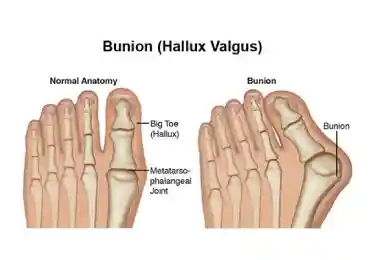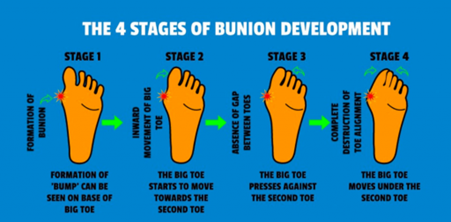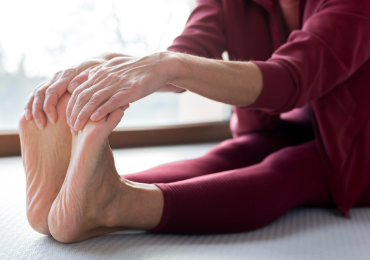What is a bunion (Hallux Valgus)
What is a bunion?
A bunion is a bony bump that forms at the base of your big toe. Bunions develop on the inside edge of your big toe joint — the metatarsophalangeal (MTP) joint. The MTP joint is where the base of your big toe meets your foot. The medical term for bunions is hallux valgus.

Types of bunions
Bunions on your big toe from extra pressure are the most common, but they can form on other toes and for other reasons, too. Other types of bunions include:
- Congenital bunions (congenital hallux valgus): Some babies are born with bunions.
- Juvenile or adolescent hallux valgus: These are types of bunions that affect people younger than 18
- Tailor’s bunion (bunionettes): Tailor’s bunions form at the base of your little (Pinky) toe. They’re usually the result of wearing shoes that don’t fit correctly or doing an activity that presses your little toe in toward your other toes.
What are the symptoms of a bunion?
What causes bunions?
There’s not just one reason why bunions develop. It’s thought that a combination of factors — like family history, abnormal bone structure, increased motion and shoe choice — can cause them. When something puts extra pressure on your big toe joint for a long time (usually years), that pressure can push your joint out of its natural alignment and toward your other toes. Eventually, a bunion forms on your MTP joint when your body compensates for your toe being pushed out of its usual place. When you have a flat foot, it puts extra pressure on the 1st Metatarsal head and toe pushing the toe inwards

Apart from Flat Foot the most common causes of extra pressure on your big toe joint include:
- Wearing narrow or pointed shoes that crowd your toes (shoes with a narrow toe box).
- The way you walk (your foot mechanics).
- Health conditions that cause inflammation (like rheumatoid arthritis or lupus).
- Standing for a long time or working on your feet.
Risk factors
Anyone can develop a bunion. Certain groups of people who are more likely to have bunions include:
- People whose biological parents have bunions or issues with their foot mechanics. More than 70% of people with bunions have a biological parent who’s had them.
- People with a history of foot injuries (including athletes).
- Flat foot aggravates the pressure on the MTP joint and toe
Complications:
- Most common is Callus and corn because of repeated pressure
- Tend to develop pain because of bursitis, Arthritis.
- Increased pressure of the metatarsal region also leads to metatarsalgia
- It could also cause other deformities of the digits liked hammer toe, mallet toe or clawed digits
Hammer Toe, Mallet Toe, Claw Toe

Its usually a bend in the toe or other digits. In Mallet toe the bend is in the distal phalanges near the nail. In Hammer toe the bend is at the middle phalanges.
One of the primary causes for development of Hammer toe apart for trauma is ill fitting shoes. Shoes that are smaller, narrow toe box cramping and clawing the digits. High Heel footwears which put extra pressure on the digits. Also, Slip-on’s though convenient increases the forefoot issues. When you walk with slip-on’s it tends to move off your foot and in order to keep it in place they hold on the toe stick for grip, which puts extra load and pressure on the digits. Other causes include imbalance of the toe muscles putting pressure on the joints and tendon.


28 thoughts on “What is a bunion (Hallux Valgus)”
Gretchen1539
July 26, 2025https://shorturl.fm/ajcMh
Elaine4370
July 26, 2025https://shorturl.fm/Ceaez
Adam3195
July 28, 2025https://shorturl.fm/4yXLo
Jordyn282
July 29, 2025https://shorturl.fm/gJ5HP
Alexia1013
July 29, 2025https://shorturl.fm/uywOC
Arianna146
July 30, 2025https://shorturl.fm/autZ0
Chance1396
August 1, 2025https://shorturl.fm/a13vm
Francisco4116
August 1, 2025https://shorturl.fm/oVcj3
Ricky2720
August 2, 2025https://shorturl.fm/vb3Wg
Giovanni4787
August 2, 2025https://shorturl.fm/QrrTj
Bradley2017
August 3, 2025https://shorturl.fm/wjy4d
Miles4376
August 4, 2025https://shorturl.fm/rw7Yf
Deirdre2497
August 4, 2025https://shorturl.fm/Qj63E
Raymond1277
August 4, 2025https://shorturl.fm/Mlvuf
Adelyn372
August 4, 2025https://shorturl.fm/hBzuv
Alan3132
August 6, 2025https://shorturl.fm/5ioNP
Brooklyn4203
August 7, 2025https://shorturl.fm/kkVf3
Hamilton2360
August 11, 2025https://shorturl.fm/gsQDj
Adrian309
August 12, 2025https://shorturl.fm/tviW8
Gareth2364
August 12, 2025https://shorturl.fm/YXvkV
Isaac1725
August 12, 2025https://shorturl.fm/MqEg8
Ally1256
August 12, 2025https://shorturl.fm/MZsrc
Harvey4987
August 14, 2025https://shorturl.fm/Ul8gS
Garrett3025
August 18, 2025https://shorturl.fm/szrLc
Chad258
September 3, 2025https://shorturl.fm/CeiXw
Mila1469
September 5, 2025https://shorturl.fm/NKmnb
Carolyn2070
September 12, 2025https://shorturl.fm/Iz0dU
Lorraine1078
October 9, 2025https://shorturl.fm/j5VOH